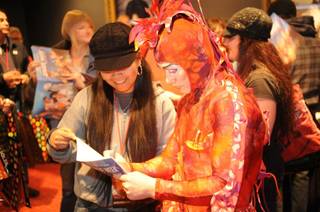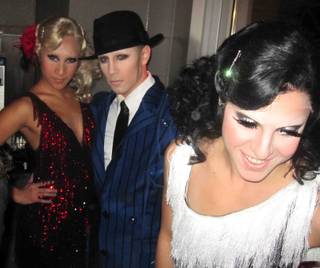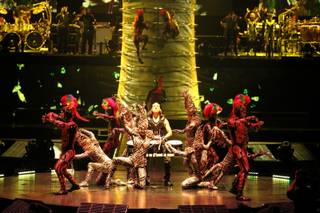
Cirque du Soleil
Cirque du Soleil’s Michael Jackson: The Immortal World Tour. The world premiere of Immortal was in Montreal, the location of Cirque headquarters, on Oct. 2, 2011.
Saturday, Dec. 3, 2011 | 2 a.m.
More Michael Jackson
Sun Coverage
The piece of scenery looms largely over “Immortal.” It is a tree, specifically an enormous oak with muscular branches spanning wide enough to hug the stage.
What of this tree, you ask, as performers in “Michael Jackson: The Immortal World Tour” play music and dance and bound about.
“Immortal” arena tour Director Jamie King knows the tree, and its history. He’s seen the real thing, and he tells its story.
“When I went to Neverland Ranch, Michael’s sanctuary, I was in his bedroom,” says King, who is also expected to direct the resident show when Cirque du Soleil moves “Immortal” to Mandalay Bay Theatre in early 2013. “You looked out and you could see a giant oak tree. What I remembered about young Michael was, he loved to climb trees … He loved it so much that he would sometimes sleep up in the tree, he would write in that tree — he wrote the ‘Dangerous’ album in that tree. He wrote a lot of poetry there, he painted there and did drawings in that tree as well.
“It was really the source of his inspiration. When I saw it, I knew I had to make it a central point in this show.”
Jackson named it “The Giving Tree.” In many ways, the tree reflects the show’s production partner, Cirque du Soleil, and its history in Las Vegas.
Nourished by millions of visitors annually to the Strip, the giving tree that is Cirque has given and given. The seeds were planted by Steve Wynn in the Mirage parking lot in November 1993 with the tent show “Nouvelle Experience.” It blossomed beautifully, over time, with “Mystere” at Treasure Island, “O” at Bellagio, “Zumanity” at New York-New York, “Ka” at MGM Grand and “Love” at Mirage. It needed some brushing up with “Believe,” which continues to sell well after a barrage of negative reviews when it opened at Luxor in 2008.
But how much more can the Cirque tree give? One of its biggest branches is falling, a first for Cirque in Vegas, as “Viva Elvis” is closing at the end of 2012.
The soil around that show has dried up even as the city braces for nearly a month of Cirque du Michael.
The “Immortal” arena tour production begins its Vegas run tonight at the 8,000-capacity Mandalay Bay Events Center. The show runs through Dec. 27, likely the most ambitious arena residency the city has seen. The cost of the production surpassed $60 million. Forty-eight trucks, more than were used by U2 during its most recent world tour, have been hauling the staging and instruments across the country. At the end of this rainbow, in late winter or early spring 2013, a new tree will take root at Mandalay Bay.
That will make it eight shows for Cirque in Las Vegas, with the Jackson show exposed to additional pressure as the company could not make its most recent partnership with the estate of a deceased and beloved entertainment icon (Elvis Presley) succeed at Aria at CityCenter.
No longer undefeated in Vegas and showing some fissures in its trunk, has the bloom left Cirque? Its top executive in Las Vegas says to put away the hatchets.
“I don’t know of anything that went wrong (with “Viva Elvis”). It was just a perfect storm, the worst possible time to open,” Cirque Senior Vice President Jerry Nadal says. “MGM got the property open, thankfully, and we opened the show right along with the property, but I just think that the news wasn’t necessarily about Elvis. The reviews, for the most part, were excellent. You look at our marketing activities and everything we put into the show, and I don’t know what hasn’t caught on. It’s done decent numbers, but it just hasn’t done what the rest of our shows usually do.”
Which is why MGM Resorts International, which made no formal announcement of its plans to clip “Viva Elvis” limbs, informed Cirque that the partnership was not working.
“I think, with eight shows in the city, that’s enough. Like the TV show ‘Eight Is Enough,’ which dates me,” Nadal says, laughing. “But I think MGM (Resorts) is out of theaters. You never say never, but with that many shows in the city, and given an economy that nobody anticipated would take so long to turn around, we will be content.”
Could it be that the Cirque business model, even in economically stable times, has become outdated? Cirque shows need to be near-capacity to succeed, and their ticket prices have for years been among the highest in the city. Reports of “Viva Elvis” playing to half-full theaters mask the fact that the show was still playing to nightly audiences of about 900. Decent, as Nadal says, except …
“I think that when people come here and see a Cirque show, they expect a big spectacle-type show,” he says, “and when you put on a big show, there is a ticket price and a certain amount of revenue that has to go with that. The Cirque name brings certain expectations with it before anybody even walks in the door. We set a pretty high bar for ourselves.”
Some longtime Vegas entertainers and entertainment officials have decried the dominance of Cirque on the Strip, saying the acrobatic and whimsical productions have robbed the city of some of its traditional star-driven shows. Gradually, a sense of Cirque backlash has grown over the past several years as the company has grown from humble beginnings.
Saxe's shot at Cirque
No one has been more vocal (and inventive, having recorded four commercials deriding the Montreal-based company) in his criticism of Cirque than show producer David Saxe, owner of V Theater and Saxe Theater at Miracle Mile Shops. Saxe is a native Las Vegan whose entire family has been immersed in Vegas entertainment — his father, Richard, was a bandleader in the Rat Pack’s heyday on the Strip, his mother danced in “Folies Bergère,” and his sister, Melinda First Lady of Magic, is making a return in “V — The Ultimate Variety Show.”
“Obviously I respect the quality of what Cirque puts onstage, and I know from my shows the effort it takes just to get one little prop done. It takes an army, and what they achieve is impressive,” Saxe says. “But I look at everything from the audience’s point of view. I think they like Cirque shows for the money, but what did they really think? A lot of people I’ve talked to are like, ‘Eh, it was OK.’ I think it’s boring, a lot of it.”
Saxe didn’t care for “Love,” even with the peerless Beatles soundscape. He compares “O” to “Waterworld Live.” He dozed off during “Ka,” and of “Viva Elvis” says, “Only Cirque could screw up Elvis in Vegas.”
The counter argument, of course, is that in terms of production value, what Cirque stages on the Strip on a nightly basis — the human-costumed, dancing sand crab in “Ka” and the silk drape covering the audience in “Love” being two random but pertinent examples — far surpasses anything rolled out at Saxe’s Miracle Mile fortress.
Still, he says, “I’m from Vegas, and when you are from here, you watch Cirque and you feel like you’ve been raided.”
Saxe’s counterpart, SPI Entertainment founder and CEO Adam Steck (who produces “Frank Marino’s Divas Las Vegas,” “Human Nature” at Imperial Palace and “Thunder From Down Under” at Excalibur) uses a more measured tone.
“I think the city, as a whole, has seen too many shows and not enough butts to fill the seats. Cirque has not been immune to that,” he says. “We have nightclubs, dayclubs, restaurants, all competing for tourists. It’s citywide.”
Of Cirque’s high level of quality, Steck says, “Hey, Cirque won’t do anything for less than $100 million, so that’s what you’re looking at. These are some of the most unbelievably produced displays of creativity you’ll see in a lifetime. But everything goes in a cycle, and I think we’ve just had one too many Cirques. They are completely brilliant, but there are not enough (ticket buyers) to go around.”
Nadal stresses that the pruning process is a manifestation of Cirque’s standard of excellence.
“People love to build you up and tear you down. That’s part of the entertainment business,” he says. “I guess, when you’re starting out, you’re the darling. When you get too big and too successful, people will start looking for something to come after you about. Luckily, for us, we’ve had mostly hits over the 27 years we’ve been in business.”
As its Jackson spectacle takes over Mandalay Bay, Cirque du Soleil is still the champion of the Strip, firmly rooted in commercial and artistic success. To borrow a phrase, the company has it made in the shade, and that is a good place to be.
Follow John Katsilometes on Twitter at Twitter.com/JohnnyKats. Also, follow “Kats With the Dish” at Twitter.com/KatsWithTheDish.






Join the Discussion:
Check this out for a full explanation of our conversion to the LiveFyre commenting system and instructions on how to sign up for an account.
Full comments policy